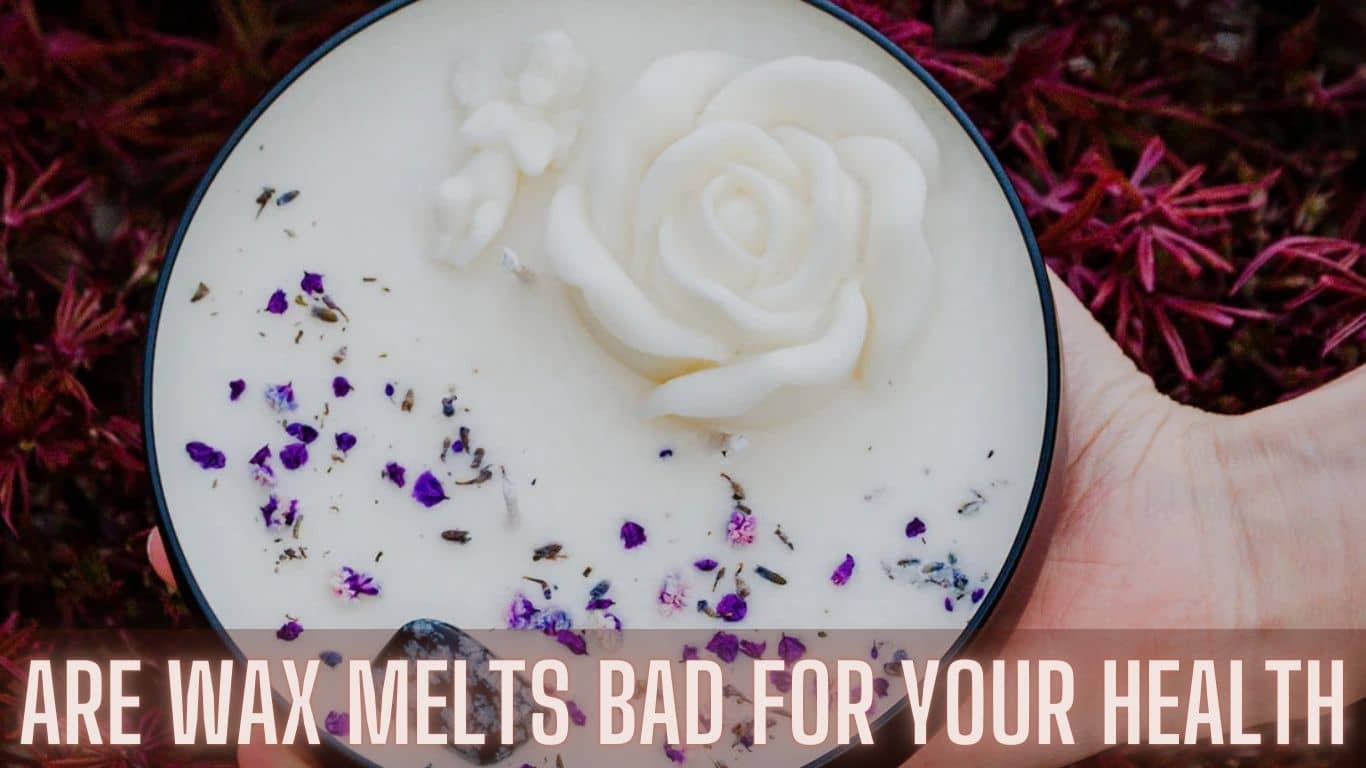Welcome to our eye-opening exploration into the world of wax melts and their potential impact on your health.
Picture this: you light a scented candle or pop in a beautiful wax melt, filling your home with a delightful fragrance.
It’s a cozy and inviting atmosphere, right? But have you ever stopped to consider the hidden dangers that may be lurking within those seemingly harmless little cubes?
In this blog post, we will delve deep into the realm of wax melts and uncover the truth about their potential health risks.
We’ll shine a light on how these innocent-looking fragrances can actually affect your indoor air quality and respiratory health.
So buckle up and join us as we navigate through the murky waters of toxic chemicals, and alternative options, and ultimately strive for a safer environment for you and your loved ones.
Get ready to discover whether your favorite scent could be doing more harm than good!
The Hidden Dangers Of Wax Melts: Are They Harmful To Your Health?
When it comes to creating a cozy and inviting atmosphere, many people turn to wax melts as an alternative to traditional candles.
After all, they’re convenient, easy to use, and come in an array of enticing scents. But what if I told you that there may be hidden dangers lurking beneath their fragrant exterior?
One major concern with wax melts is their impact on indoor air quality. As these little cubes melt away, they release volatile organic compounds (VOCs) into the air we breathe.
These VOCs can include harmful chemicals like benzene and formaldehyde, which have been linked to respiratory issues and even cancer.
But it’s not just the VOCs that pose a risk. Many commercially available wax melts also contain synthetic fragrance oils that can irritate sensitive individuals or trigger allergies.
These artificial fragrances often contain phthalates – chemicals known for disrupting hormone levels and potentially causing reproductive harm.
The way we use wax melts also plays a role in their potential health risks.
When heated at high temperatures or left unattended for extended periods of time, they may release more toxins into the air than when used responsibly.
Stay tuned as we delve deeper into this topic by investigating specific health effects associated with using wax melts!
Unveiling The Health Risks Of Using Wax Melts In Your Home:

When it comes to creating a cozy and inviting atmosphere, many people turn to wax melts for their delightful scents.
However, what you may not realize is that these seemingly harmless wax melts could potentially be posing health risks to you and your loved ones.
One of the primary concerns associated with using wax melts is their impact on indoor air quality.
As the wax heats up and releases fragrance into the air, it can also release harmful chemicals such as formaldehyde, benzene, and toluene.
These volatile organic compounds (VOCs) can irritate the respiratory system and contribute to allergic reactions or asthma attacks.
It’s important to consider how your favorite scent is affecting your well-being.
While enjoying pleasant aromas at home is undoubtedly enjoyable, it’s crucial to take steps toward minimizing potential health risks associated with wax melts.
Stay tuned for our next blog post where we’ll delve deeper into the toxic chemicals found in certain types of wax melts and explore safer alternatives for creating a beautifully scented environment without compromising your health!
Wax Melts And Indoor Air Quality: Understanding The Health Impact
Wax melts have become a popular choice for adding fragrance to our homes.
These small, colorful cubes of wax are placed in a warmer and slowly melted, releasing delightful scents into the air.
But have you ever stopped to consider the potential impact on your indoor air quality? It’s time to shed some light on this issue.
Indoor air quality is an important factor when it comes to maintaining a healthy home environment.
Unfortunately, many wax melts contain synthetic fragrances that can release harmful chemicals into the air when heated.
These chemicals, such as phthalates and volatile organic compounds (VOCs), can contribute to poor indoor air quality and may have adverse effects on our health.
Phthalates are commonly used in fragrances to enhance their longevity.
However, studies have shown that exposure to phthalates can lead to various health issues including hormone disruption and respiratory problems.
VOCs, on the other hand, are released from both natural and synthetic sources and can cause eye irritation, headaches, dizziness, and even more serious long-term health effects.
Another alternative is using beeswax or soy-based candles instead of traditional wax melts.
Beeswax candles produce negative ions which help purify the air while soy-based candles burn cleaner than paraffin candles commonly found in stores.
Is Your Favorite Scent Harming You? Investigating Wax Melts’ Health Effects:

When you light a wax melt, it’s hard not to get lost in the delightful aroma that fills your home.
But have you ever stopped to consider the potential health effects of these seemingly harmless fragrances?
One major issue with wax melts is their impact on indoor air quality.
As they melt, toxic compounds can be released into the air we breathe.
These compounds include volatile organic compounds (VOCs) such as benzene and formaldehyde, which have been linked to respiratory problems and even cancer.
In addition to VOCs, many commercial wax melts also contain synthetic fragrances that can trigger allergies and asthma symptoms in sensitive individuals.
These artificial scents often contain phthalates, which are known endocrine disruptors that can interfere with hormone function.
Let’s prioritize our health by being mindful of what we expose ourselves and our loved ones to – choose healthier home fragrance options today!
Toxic Chemicals In Wax Melts: What You Need To Know For Your Health
When it comes to creating a warm and inviting atmosphere in our homes, many of us turn to wax melts.
These small fragrant cubes are melted with the help of a tea light or an electric warmer, releasing delightful scents into the air.
But have you ever wondered what exactly is in those innocent-looking wax melts?
Unfortunately, not all wax melts are created equal, and some can contain toxic chemicals that may pose risks to your health.
One common culprit is phthalates – chemicals used to make fragrances last longer. Phthalates have been linked to hormonal disruptions and reproductive issues.
Another concerning ingredient often found in wax melts is benzene – a known carcinogen. Benzene has been associated with various types of cancer including leukemia.
Paraffin wax, which is frequently used as the base for many commercial wax melts, can also release harmful pollutants when burned.
These include formaldehyde and acrolein, both of which can irritate the respiratory system and worsen conditions like asthma.
You could also consider making your own DIY wax melts using organic ingredients like essential oils and natural waxes like soy or coconut oil. This way, you have full control over what goes into them.
It’s important to be aware of the potential risks associated with using certain types of wax melts in order to make informed choices about home fragrance products that prioritize your health and well-being.
Safe Alternatives To Wax Melts: Protecting Your Health And Well-Being

When it comes to creating a pleasing ambiance in your home, you don’t have to sacrifice your health.
Fortunately, there are safe alternatives to wax melts that can still fill your space with delightful fragrances without compromising your well-being.
One option is using essential oils. These natural extracts from plants not only emit pleasant scents but also offer therapeutic benefits.
You can use an oil diffuser or create your own homemade spray by mixing a few drops of essential oil with water in a spray bottle.
Another alternative worth considering is soy-based candles. Unlike traditional paraffin candles, soy candles are made from renewable resources and do not release harmful chemicals when burned.
Look for brands that use pure soy wax and non-toxic fragrance oils for the safest choice.
Potpourri can be a charming way to add fragrance to your home naturally.
Opt for organic or dried flower petals mixed with aromatic herbs and spices like lavender or cinnamon sticks.
Place them in decorative bowls around your house for a subtle yet inviting aroma.
By exploring these safer alternatives, you can enjoy beautiful scents while safeguarding both yourself and those you love from potential health risks associated with wax melts.
Wax Melts And Respiratory Health: A Closer Look At The Connection
Wax melts have become increasingly popular for adding a pleasant fragrance to our homes.
However, the impact of these scented wax cubes on our respiratory health is often overlooked.
Let’s take a closer look at the connection between wax melts and respiratory health.
When we heat wax melts, they release volatile organic compounds (VOCs) into the air.
These VOCs can irritate the respiratory system and worsen existing conditions such as asthma or allergies.
In fact, research has shown that exposure to high levels of VOCs can lead to respiratory problems like coughing, wheezing, and shortness of breath.
Furthermore, some wax melts contain synthetic fragrances that can be particularly harmful to sensitive individuals.
These artificial fragrances often contain phthalates which are known endocrine disruptors and can negatively affect lung function.
It’s important to note that not all wax melts are created equal in terms of their impact on respiratory health.
Some brands use natural ingredients and essential oils instead of synthetic fragrances, making them a safer option for those concerned about their lung health.
While using wax melts may provide an enjoyable aroma in your home, it’s crucial to be aware of their potential impact on your respiratory health.
By choosing safer alternatives and being mindful of ingredient labels, you can still enjoy a pleasant scent without compromising your well-being.
Choosing Healthier Home Fragrance Options: Reducing Risks From Wax Melts
When it comes to creating a pleasant and inviting atmosphere in our homes, many of us turn to wax melts as a popular choice for fragrance.
One alternative worth considering is natural essential oils. These oils are derived from plants and offer a wide range of aromatic scents without the use of any synthetic chemicals.
They can be used in diffusers or diluted with water and sprayed into the air to create a refreshing ambiance.
Another option is beeswax candles, which not only emit a lovely scent but also burn cleanly without releasing harmful toxins into the air.
Beeswax has natural purifying properties and produces negative ions when burned, helping improve indoor air quality.
For those who prefer flameless options, reed diffusers are an excellent choice.
They work by using porous reeds to absorb scented oil from a bottle and release it gradually into the air.
This method provides a long-lasting fragrance without any heat or open flames.
If you’re looking for convenience, consider electric wax warmers that use soy-based wax melts instead of paraffin-based ones.
Soy wax is considered safer because it’s made from renewable resources and doesn’t release toxic chemicals when melted.
While traditional wax melts may pose potential health risks due to their chemical composition, choosing healthier alternatives such as natural essential oils, beeswax candles, reed diffusers, or soy-based wax melts can help mitigate these concerns while still filling your home with delightful fragrances.
Conclusion:
It is important to be aware of the potential health risks associated with using wax melts in your home.
While they may create a pleasant and inviting ambiance, these seemingly harmless products can release toxic chemicals into the air, compromising indoor air quality and posing a threat to respiratory health.
Wax melts often contain ingredients such as paraffin wax and synthetic fragrances that can emit harmful compounds like formaldehyde, benzene, and toluene when heated.
These chemicals have been linked to various health issues including allergies, asthma exacerbation, headaches, dizziness, and even long-term effects on neurological function.
When choosing home fragrance products, it is crucial to read labels carefully and opt for those made from non-toxic materials.
Look for products that are free from phthalates and other harmful additives.
Additionally, consider proper ventilation by opening windows or using an air purifier to help reduce any potential buildup of pollutants in your living space.
Protecting our health should always be a top priority. By understanding the risks associated with wax melts and making informed choices about alternative fragrance options for our homes, we can create an environment that promotes well-being while still enjoying pleasant scents throughout our living spaces.




